Coronary Microvascular Dysfunction - Epidemiology, Pathogenesis, Prognosis, Diagnosis, Risk Factors and Therapy
- PMID: 27904032
- PMCID: PMC8607842
- DOI: 10.1253/circj.CJ-16-1002
Coronary Microvascular Dysfunction - Epidemiology, Pathogenesis, Prognosis, Diagnosis, Risk Factors and Therapy
Abstract
Angina has traditionally been thought to be caused by obstructive coronary artery disease (CAD). However, a substantial number of patients with angina are found to not have obstructive CAD when undergoing coronary angiography. A significant proportion of these patients have coronary microvascular dysfunction (CMD), characterized by heightened sensitivity to vasoconstrictor stimuli and limited microvascular vasodilator capacity. With the advent of non-invasive and invasive techniques, the coronary microvasculature has been more extensively studied in the past 2 decades. CMD has been identified as a cause of cardiac ischemia, in addition to traditional atherosclerotic disease and vasospastic disease. CMD can occur alone or in the presence obstructive CAD. CMD shares many similar risk factors with macrovascular CAD. Diagnosis is achieved through detection of an attenuated response of coronary blood flow in response to vasodilatory agents. Imaging modalities such as cardiovascular magnetic resonance, positron emission tomography, and transthoracic Doppler echocardiography have become more widely used, but have not yet completely replaced the traditional intracoronary vasoreactivity testing. Treatment of CMD starts with lifestyle modification and risk factor control. The use of traditional antianginal, antiatherosclerotic medications and some novel agents may be beneficial; however, clinical trials are needed to assess the efficacy of the pharmacologic and non-pharmacologic therapeutic modalities. In addition, studies with longer-term follow-up are needed to determine the prognostic benefits of these agents. We review the epidemiology, prognosis, pathogenesis, diagnosis, risk factors and current therapies for CMD.
Figures





Similar articles
-
Peripheral Reactive Hyperemia Index and Coronary Microvascular Function in Women With no Obstructive CAD: The iPOWER Study.JACC Cardiovasc Imaging. 2016 Apr;9(4):411-7. doi: 10.1016/j.jcmg.2016.02.005. JACC Cardiovasc Imaging. 2016. PMID: 27056160
-
Coronary microvascular disease in women: epidemiology, mechanisms, evaluation, and treatment.Can J Physiol Pharmacol. 2024 Oct 1;102(10):594-606. doi: 10.1139/cjpp-2023-0414. Epub 2024 May 10. Can J Physiol Pharmacol. 2024. PMID: 38728748 Review.
-
Evaluation of non-invasive imaging parameters in coronary microvascular disease: a systematic review.BMC Med Imaging. 2021 Jan 6;21(1):5. doi: 10.1186/s12880-020-00535-7. BMC Med Imaging. 2021. PMID: 33407208 Free PMC article.
-
Coronary Microvascular Dysfunction: A Practical Approach to Diagnosis and Management.Curr Atheroscler Rep. 2021 Jul 16;23(9):54. doi: 10.1007/s11883-021-00947-y. Curr Atheroscler Rep. 2021. PMID: 34268637 Review.
-
Developments and Controversies in Invasive Diagnosis of Coronary Microvascular Dysfunction in Angina With Nonobstructive Coronary Arteries.Mayo Clin Proc. 2024 Sep;99(9):1469-1481. doi: 10.1016/j.mayocp.2024.04.022. Mayo Clin Proc. 2024. PMID: 39232622 Review.
Cited by
-
From Structural to Functional Hypertension Mediated Target Organ Damage-A Long Way to Heart Failure with Preserved Ejection Fraction.J Clin Med. 2022 Sep 13;11(18):5377. doi: 10.3390/jcm11185377. J Clin Med. 2022. PMID: 36143024 Free PMC article. Review.
-
Endothelial-cell-mediated mechanism of coronary microvascular dysfunction leading to heart failure with preserved ejection fraction.Heart Fail Rev. 2023 Jan;28(1):169-178. doi: 10.1007/s10741-022-10224-y. Epub 2022 Mar 9. Heart Fail Rev. 2023. PMID: 35266091 Free PMC article. Review.
-
Perturbations in myocardial perfusion and oxygen balance in swine with multiple risk factors: a novel model of ischemia and no obstructive coronary artery disease.Basic Res Cardiol. 2020 Feb 25;115(2):21. doi: 10.1007/s00395-020-0778-2. Basic Res Cardiol. 2020. PMID: 32100119 Free PMC article.
-
Molecular mechanisms of endothelial dysfunction in coronary microcirculation dysfunction.J Thromb Thrombolysis. 2023 Oct;56(3):388-397. doi: 10.1007/s11239-023-02862-2. Epub 2023 Jul 19. J Thromb Thrombolysis. 2023. PMID: 37466848 Review.
-
Microvascular vasoregulatory dysfunction in African Americans - An enhanced opportunity for early prevention and treatment of atherosclerotic cardiovascular disease.Am Heart J Plus. 2024 Mar 10;40:100382. doi: 10.1016/j.ahjo.2024.100382. eCollection 2024 Apr. Am Heart J Plus. 2024. PMID: 38586429 Free PMC article.
References
-
- Day LJ, Sowton E. Clinical features and follow-up of patients with angina and normal coronary arteries. Lancet 1976; 2: 334–337. - PubMed
-
- Bemiller CR, Pepine CJ, Rogers AK. Long-term observations in patients with angina and normal coronary arteriograms. Circulation 1973; 47: 36–43. - PubMed
-
- Suwaidi JA, Hamasaki S, Higano ST, Nishimura RA, Holmes DR Jr, Lerman A. Long-term follow-up of patients with mild coronary artery disease and endothelial dysfunction. Circulation 2000; 101: 948–954. - PubMed
Publication types
MeSH terms
Grants and funding
- N01 HV068161/HV/NHLBI NIH HHS/United States
- U01 HL064829/HL/NHLBI NIH HHS/United States
- R03 AG032631/AG/NIA NIH HHS/United States
- T32 HL069751/HL/NHLBI NIH HHS/United States
- UL1 TR000124/TR/NCATS NIH HHS/United States
- N01 HV068164/HV/NHLBI NIH HHS/United States
- M01 RR000425/RR/NCRR NIH HHS/United States
- N01 HV068162/HL/NHLBI NIH HHS/United States
- K23 HL105787/HL/NHLBI NIH HHS/United States
- R01 HL090957/HL/NHLBI NIH HHS/United States
- UL1 TR000064/TR/NCATS NIH HHS/United States
- N01 HV068163/HL/NHLBI NIH HHS/United States
LinkOut - more resources
Full Text Sources
Other Literature Sources
Medical
Miscellaneous

